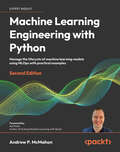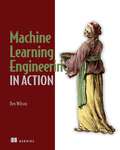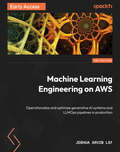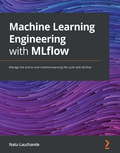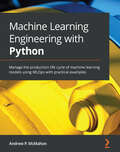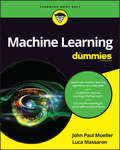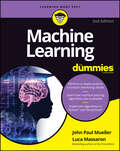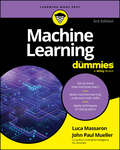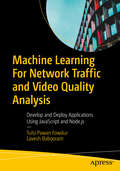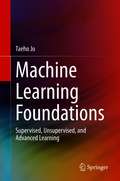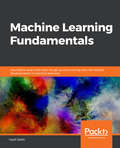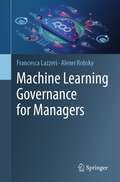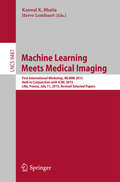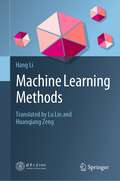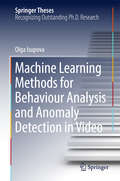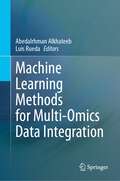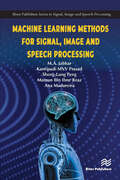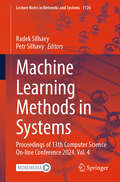- Table View
- List View
Machine Learning Engineering with Python: Manage the lifecycle of machine learning models using MLOps with practical examples
by Andrew P. McMahonTransform your machine learning projects into successful deployments with this practical guide on how to build and scale solutions that solve real-world problems Includes a new chapter on generative AI and large language models (LLMs) and building a pipeline that leverages LLMs using LangChainKey FeaturesThis second edition delves deeper into key machine learning topics, CI/CD, and system designExplore core MLOps practices, such as model management and performance monitoringBuild end-to-end examples of deployable ML microservices and pipelines using AWS and open-source toolsBook DescriptionThe Second Edition of Machine Learning Engineering with Python is the practical guide that MLOps and ML engineers need to build solutions to real-world problems. It will provide you with the skills you need to stay ahead in this rapidly evolving field. The book takes an examples-based approach to help you develop your skills and covers the technical concepts, implementation patterns, and development methodologies you need. You'll explore the key steps of the ML development lifecycle and create your own standardized "model factory" for training and retraining of models. You'll learn to employ concepts like CI/CD and how to detect different types of drift. Get hands-on with the latest in deployment architectures and discover methods for scaling up your solutions. This edition goes deeper in all aspects of ML engineering and MLOps, with emphasis on the latest open-source and cloud-based technologies. This includes a completely revamped approach to advanced pipelining and orchestration techniques. With a new chapter on deep learning, generative AI, and LLMOps, you will learn to use tools like LangChain, PyTorch, and Hugging Face to leverage LLMs for supercharged analysis. You will explore AI assistants like GitHub Copilot to become more productive, then dive deep into the engineering considerations of working with deep learning.What you will learnPlan and manage end-to-end ML development projectsExplore deep learning, LLMs, and LLMOps to leverage generative AIUse Python to package your ML tools and scale up your solutionsGet to grips with Apache Spark, Kubernetes, and RayBuild and run ML pipelines with Apache Airflow, ZenML, and KubeflowDetect drift and build retraining mechanisms into your solutionsImprove error handling with control flows and vulnerability scanningHost and build ML microservices and batch processes running on AWSWho this book is forThis book is designed for MLOps and ML engineers, data scientists, and software developers who want to build robust solutions that use machine learning to solve real-world problems. If you’re not a developer but want to manage or understand the product lifecycle of these systems, you’ll also find this book useful. It assumes a basic knowledge of machine learning concepts and intermediate programming experience in Python. With its focus on practical skills and real-world examples, this book is an essential resource for anyone looking to advance their machine learning engineering career.
Machine Learning Engineering in Action
by Ben WilsonField-tested tips, tricks, and design patterns for building machine learning projects that are deployable, maintainable, and secure from concept to production.In Machine Learning Engineering in Action, you will learn: Evaluating data science problems to find the most effective solution Scoping a machine learning project for usage expectations and budget Process techniques that minimize wasted effort and speed up production Assessing a project using standardized prototyping work and statistical validation Choosing the right technologies and tools for your project Making your codebase more understandable, maintainable, and testable Automating your troubleshooting and logging practices Ferrying a machine learning project from your data science team to your end users is no easy task. Machine Learning Engineering in Action will help you make it simple. Inside, you'll find fantastic advice from veteran industry expert Ben Wilson, Principal Resident Solutions Architect at Databricks. Ben introduces his personal toolbox of techniques for building deployable and maintainable production machine learning systems. You'll learn the importance of Agile methodologies for fast prototyping and conferring with stakeholders, while developing a new appreciation for the importance of planning. Adopting well-established software development standards will help you deliver better code management, and make it easier to test, scale, and even reuse your machine learning code. Every method is explained in a friendly, peer-to-peer style and illustrated with production-ready source code. About the technology Deliver maximum performance from your models and data. This collection of reproducible techniques will help you build stable data pipelines, efficient application workflows, and maintainable models every time. Based on decades of good software engineering practice, machine learning engineering ensures your ML systems are resilient, adaptable, and perform in production. About the book Machine Learning Engineering in Action teaches you core principles and practices for designing, building, and delivering successful machine learning projects. You'll discover software engineering techniques like conducting experiments on your prototypes and implementing modular design that result in resilient architectures and consistent cross-team communication. Based on the author's extensive experience, every method in this book has been used to solve real-world projects. What's inside Scoping a machine learning project for usage expectations and budget Choosing the right technologies for your design Making your codebase more understandable, maintainable, and testable Automating your troubleshooting and logging practices About the reader For data scientists who know machine learning and the basics of object-oriented programming. About the author Ben Wilson is Principal Resident Solutions Architect at Databricks, where he developed the Databricks Labs AutoML project, and is an MLflow committer.
Machine Learning Engineering on AWS: Build, scale, and secure machine learning systems and MLOps pipelines in production
by Joshua Arvin LatWork seamlessly with production-ready machine learning systems and pipelines on AWS by addressing key pain points encountered in the ML life cycleKey FeaturesGain practical knowledge of managing ML workloads on AWS using Amazon SageMaker, Amazon EKS, and moreUse container and serverless services to solve a variety of ML engineering requirementsDesign, build, and secure automated MLOps pipelines and workflows on AWSBook DescriptionThere is a growing need for professionals with experience in working on machine learning (ML) engineering requirements as well as those with knowledge of automating complex MLOps pipelines in the cloud. This book explores a variety of AWS services, such as Amazon Elastic Kubernetes Service, AWS Glue, AWS Lambda, Amazon Redshift, and AWS Lake Formation, which ML practitioners can leverage to meet various data engineering and ML engineering requirements in production.This machine learning book covers the essential concepts as well as step-by-step instructions that are designed to help you get a solid understanding of how to manage and secure ML workloads in the cloud. As you progress through the chapters, you'll discover how to use several container and serverless solutions when training and deploying TensorFlow and PyTorch deep learning models on AWS. You'll also delve into proven cost optimization techniques as well as data privacy and model privacy preservation strategies in detail as you explore best practices when using each AWS.By the end of this AWS book, you'll be able to build, scale, and secure your own ML systems and pipelines, which will give you the experience and confidence needed to architect custom solutions using a variety of AWS services for ML engineering requirements.What you will learnFind out how to train and deploy TensorFlow and PyTorch models on AWSUse containers and serverless services for ML engineering requirementsDiscover how to set up a serverless data warehouse and data lake on AWSBuild automated end-to-end MLOps pipelines using a variety of servicesUse AWS Glue DataBrew and SageMaker Data Wrangler for data engineeringExplore different solutions for deploying deep learning models on AWSApply cost optimization techniques to ML environments and systemsPreserve data privacy and model privacy using a variety of techniquesWho this book is forThis book is for machine learning engineers, data scientists, and AWS cloud engineers interested in working on production data engineering, machine learning engineering, and MLOps requirements using a variety of AWS services such as Amazon EC2, Amazon Elastic Kubernetes Service (EKS), Amazon SageMaker, AWS Glue, Amazon Redshift, AWS Lake Formation, and AWS Lambda -- all you need is an AWS account to get started. Prior knowledge of AWS, machine learning, and the Python programming language will help you to grasp the concepts covered in this book more effectively.
Machine Learning Engineering on AWS: Operationalize and optimize generative AI systems and LLMOps pipelines in production
by Joshua Arvin LatSolve machine learning engineering challenges for GenAI applications on AWS and automate the LLMOps workflows using AWS services like Amazon Bedrock and Amazon SageMakerKey FeaturesLearn how to build RAG and agent-based GenAI apps with AWS servicesLeverage Amazon Bedrock for secure, responsible AI, and next-gen Amazon SageMaker for data, analytics, and ML engineeringApply access controls, compliance features, and best practices to ensure robust ML system securityPurchase of the print or Kindle book includes a free PDF eBookBook DescriptionRecent advancements in generative AI, large language models (LLMs), Retrieval-Augmented Generation (RAG), and AI agents have created a soaring demand for machine learning engineers who can build, manage, and scale modern AI-powered systems. To stay ahead in this rapidly evolving AI landscape, you need a deep theoretical understanding as well as hands-on expertise with the right tools, services, and platforms. Machine Learning Engineering on AWS is a practical guide that teaches you how to harness AWS services such as Amazon Bedrock and the next generation of Amazon SageMaker to build, optimize, and manage production-ready ML systems. You’ll learn how to build RAG-powered GenAI applications, automate LLMOps workflows, develop reliable and responsible AI agents, and optimize a managed transactional data lake. The book also covers proven deployment and evaluation strategies for dealing with various models, along with practical examples to help you manage, troubleshoot, and optimize ML systems running on AWS. Guided by AWS Machine Learning Hero Joshua Arvin Lat, you’ll be able to grasp complex ML concepts with clarity and gain the confidence to operationalize and secure GenAI applications on AWS to meet a wide variety of ML engineering requirements.What you will learnImplement model distillation techniques to build cost-efficient modelsDevelop RAG and agent-based generative AI applicationsLeverage fully managed Apache Iceberg tables with Amazon S3 tablesAutomate production-ready end-to-end machine learning pipelines on AWSMonitor models, data, and infrastructure to detect potential issuesApply proven cost optimization techniques for generative AI systemsWho this book is forThis book is for AI engineers, data scientists, machine learning engineers, and technology leaders who want to learn more about machine learning engineering, GenAI, LLMs, RAG, AI agents, and MLOps on AWS. A basic understanding of artificial intelligence, machine learning, generative AI, and cloud engineering concepts is a must.
Machine Learning Engineering with MLflow: Manage the end-to-end machine learning life cycle with MLflow
by Natu LauchandeGet up and running, and productive in no time with MLflow using the most effective machine learning engineering approachKey FeaturesExplore machine learning workflows for stating ML problems in a concise and clear manner using MLflowUse MLflow to iteratively develop a ML model and manage it Discover and work with the features available in MLflow to seamlessly take a model from the development phase to a production environmentBook DescriptionMLflow is a platform for the machine learning life cycle that enables structured development and iteration of machine learning models and a seamless transition into scalable production environments.This book will take you through the different features of MLflow and how you can implement them in your ML project. You will begin by framing an ML problem and then transform your solution with MLflow, adding a workbench environment, training infrastructure, data management, model management, experimentation, and state-of-the-art ML deployment techniques on the cloud and premises. The book also explores techniques to scale up your workflow as well as performance monitoring techniques. As you progress, you'll discover how to create an operational dashboard to manage machine learning systems. Later, you will learn how you can use MLflow in the AutoML, anomaly detection, and deep learning context with the help of use cases. In addition to this, you will understand how to use machine learning platforms for local development as well as for cloud and managed environments. This book will also show you how to use MLflow in non-Python-based languages such as R and Java, along with covering approaches to extend MLflow with Plugins.By the end of this machine learning book, you will be able to produce and deploy reliable machine learning algorithms using MLflow in multiple environments.What you will learnDevelop your machine learning project locally with MLflow's different featuresSet up a centralized MLflow tracking server to manage multiple MLflow experimentsCreate a model life cycle with MLflow by creating custom modelsUse feature streams to log model results with MLflowDevelop the complete training pipeline infrastructure using MLflow featuresSet up an inference-based API pipeline and batch pipeline in MLflowScale large volumes of data by integrating MLflow with high-performance big data librariesWho this book is forThis book is for data scientists, machine learning engineers, and data engineers who want to gain hands-on machine learning engineering experience and learn how they can manage an end-to-end machine learning life cycle with the help of MLflow. Intermediate-level knowledge of the Python programming language is expected.
Machine Learning Engineering with Python: Manage the production life cycle of machine learning models using MLOps with practical examples
by Andrew P. McMahonSupercharge the value of your machine learning models by building scalable and robust solutions that can serve them in production environmentsKey FeaturesExplore hyperparameter optimization and model management toolsLearn object-oriented programming and functional programming in Python to build your own ML libraries and packagesExplore key ML engineering patterns like microservices and the Extract Transform Machine Learn (ETML) pattern with use casesBook DescriptionMachine learning engineering is a thriving discipline at the interface of software development and machine learning. This book will help developers working with machine learning and Python to put their knowledge to work and create high-quality machine learning products and services. Machine Learning Engineering with Python takes a hands-on approach to help you get to grips with essential technical concepts, implementation patterns, and development methodologies to have you up and running in no time. You'll begin by understanding key steps of the machine learning development life cycle before moving on to practical illustrations and getting to grips with building and deploying robust machine learning solutions. As you advance, you'll explore how to create your own toolsets for training and deployment across all your projects in a consistent way. The book will also help you get hands-on with deployment architectures and discover methods for scaling up your solutions while building a solid understanding of how to use cloud-based tools effectively. Finally, you'll work through examples to help you solve typical business problems. By the end of this book, you'll be able to build end-to-end machine learning services using a variety of techniques and design your own processes for consistently performant machine learning engineering.What you will learnFind out what an effective ML engineering process looks likeUncover options for automating training and deployment and learn how to use themDiscover how to build your own wrapper libraries for encapsulating your data science and machine learning logic and solutionsUnderstand what aspects of software engineering you can bring to machine learningGain insights into adapting software engineering for machine learning using appropriate cloud technologiesPerform hyperparameter tuning in a relatively automated wayWho this book is forThis book is for machine learning engineers, data scientists, and software developers who want to build robust software solutions with machine learning components. If you're someone who manages or wants to understand the production life cycle of these systems, you'll find this book useful. Intermediate-level knowledge of Python is necessary.
Machine Learning For Dummies
by John Paul Mueller Luca MassaronYour no-nonsense guide to making sense of machine learning Machine learning can be a mind-boggling concept for the masses, but those who are in the trenches of computer programming know just how invaluable it is. Without machine learning, fraud detection, web search results, real-time ads on web pages, credit scoring, automation, and email spam filtering wouldn't be possible, and this is only showcasing just a few of its capabilities. Written by two data science experts, Machine Learning For Dummies offers a much-needed entry point for anyone looking to use machine learning to accomplish practical tasks. Covering the entry-level topics needed to get you familiar with the basic concepts of machine learning, this guide quickly helps you make sense of the programming languages and tools you need to turn machine learning-based tasks into a reality. Whether you're maddened by the math behind machine learning, apprehensive about AI, perplexed by preprocessing data--or anything in between--this guide makes it easier to understand and implement machine learning seamlessly. Grasp how day-to-day activities are powered by machine learning Learn to 'speak' certain languages, such as Python and R, to teach machines to perform pattern-oriented tasks and data analysis Learn to code in R using R Studio Find out how to code in Python using Anaconda Dive into this complete beginner's guide so you are armed with all you need to know about machine learning!
Machine Learning For Dummies
by John Paul Mueller Luca MassaronYour comprehensive entry-level guide to machine learning While machine learning expertise doesn’t quite mean you can create your own Turing Test-proof android—as in the movie Ex Machina—it is a form of artificial intelligence and one of the most exciting technological means of identifying opportunities and solving problems fast and on a large scale. Anyone who masters the principles of machine learning is mastering a big part of our tech future and opening up incredible new directions in careers that include fraud detection, optimizing search results, serving real-time ads, credit- scoring, building accurate and sophisticated pricing models—and way, way more. Unlike most machine learning books, the fully updated 2nd Edition of Machine Learning For Dummies doesn’t assume you have years of experience using programming languages such as Python (R source is also included in a downloadable form with comments and explanations), but lets you in on the ground floor, covering the entry-level materials that will get you up and running building models you need to perform practical tasks. It takes a look at the underlying—and fascinating—math principles that power machine learning but also shows that you don’t need to be a math whiz to build fun new tools and apply them to your work and study. Understand the history of AI and machine learning Work with Python 3.8 and TensorFlow 2.x (and R as a download) Build and test your own models Use the latest datasets, rather than the worn out data found in other books Apply machine learning to real problems Whether you want to learn for college or to enhance your business or career performance, this friendly beginner’s guide is your best introduction to machine learning, allowing you to become quickly confident using this amazing and fast-developing technology that’s impacting lives for the better all over the world.
Machine Learning For Dummies
by John Paul Mueller Luca MassaronThe most human-friendly book on machine learning Somewhere buried in all the systems that drive artificial intelligence, you'll find machine learning—the process that allows technology to build knowledge based on data and patterns. Machine Learning For Dummies is an excellent starting point for anyone who wants deeper insight into how all this learning actually happens. This book offers an overview of machine learning and its most important practical applications. Then, you'll dive into the tools, code, and math that make machine learning go—and you'll even get step-by-step instructions for testing it out on your own. For an easy-to-follow introduction to building smart algorithms, this Dummies guide is your go-to. Piece together what machine learning is, what it can do, and what it can't do Learn the basics of machine learning code and how it integrates with large datasets Understand the mathematical principles that AI uses to make itself smarter Consider real-world applications of machine learning and write your own algorithms With clear explanations and hands-on instruction, Machine Learning For Dummies is a great entry-level resource for developers looking to get started with AI and machine learning.
Machine Learning For Network Traffic and Video Quality Analysis: Develop and Deploy Applications Using JavaScript and Node.js
by Tulsi Pawan Fowdur Lavesh BabooramThis book offers both theoretical insights and hands-on experience in understanding and building machine learning-based Network Traffic Monitoring and Analysis (NTMA) and Video Quality Assessment (VQA) applications using JavaScript. JavaScript provides the flexibility to deploy these applications across various devices and web browsers. The book begins by delving into NTMA, explaining fundamental concepts and providing an overview of existing applications and research within this domain. It also goes into the essentials of VQA and offers a survey of the latest developments in VQA algorithms. The book includes a thorough examination of machine learning algorithms that find application in both NTMA and VQA, with a specific emphasis on classification and prediction algorithms such as the Multi-Layer Perceptron and Support Vector Machine. The book also explores the software architecture of the NTMA client-server application. This architecture is meticulously developed using HTML, CSS, Node.js, and JavaScript. Practical aspects of developing the Video Quality Assessment (VQA) model using JavaScript and Java are presented. Lastly, the book provides detailed guidance on implementing a complete system model that seamlessly merges NTMA and VQA into a unified web application, all built upon a client-server paradigm. By the end of the book, you will understand NTMA and VQA concepts and will be able to apply machine learning to both domains and develop and deploy your own NTMA and VQA applications using JavaScript and Node.js. What You Will Learn What are the fundamental concepts, existing applications, and research on NTMA? What are the existing software and current research trends in VQA? Which machine learning algorithms are used in NTMA and VQA? How do you develop NTMA and VQA web-based applications using JavaScript, HTML, and Node.js? Who This Book Is For Software professionals and machine learning engineers involved in the fields of networking and telecommunications
Machine Learning Forensics for Law Enforcement, Security, and Intelligence
by Jesus MenaIncreasingly, crimes and fraud are digital in nature, occurring at breakneck speed and encompassing large volumes of data. To combat this unlawful activity, knowledge about the use of machine learning technology and software is critical. Machine Learning Forensics for Law Enforcement, Security, and Intelligence integrates an assortment of deductive
Machine Learning Foundations: Supervised, Unsupervised, and Advanced Learning
by Taeho JoThis book provides conceptual understanding of machine learning algorithms though supervised, unsupervised, and advanced learning techniques. The book consists of four parts: foundation, supervised learning, unsupervised learning, and advanced learning. The first part provides the fundamental materials, background, and simple machine learning algorithms, as the preparation for studying machine learning algorithms. The second and the third parts provide understanding of the supervised learning algorithms and the unsupervised learning algorithms as the core parts. The last part provides advanced machine learning algorithms: ensemble learning, semi-supervised learning, temporal learning, and reinforced learning.Provides comprehensive coverage of both learning algorithms: supervised and unsupervised learning;Outlines the computation paradigm for solving classification, regression, and clustering;Features essential techniques for building the a new generation of machine learning.
Machine Learning Fundamentals
by Hyatt SalehMachine Learning Fundamentals is designed for developers who are new to the field of machine learning and want to learn how to use the scikit-learn library to develop machine learning algorithms. You must have some knowledge and experience in Python programming, but you do not need any prior knowledge of scikit-learn or machine learning algorithms.
Machine Learning Governance for Managers
by Francesca Lazzeri Alexei RobskyMachine Learning Governance for Managers provides readers with the knowledge to unlock insights from data and leverage AI solutions. In today's business landscape, most organizations face challenges in scaling and maintaining a sustainable machine learning model lifecycle. This book offers a comprehensive framework that covers business requirements, data generation and acquisition, modeling, model deployment, performance measurement, and management, providing a range of methodologies, technologies, and resources to assist data science managers in adopting data and AI-driven practices. Particular emphasis is given to ramping up a solution quickly, detailing skills and techniques to ensure the right things are measured and acted upon for reliable results and high performance. Readers will learn sustainable tools for implementing machine learning with existing IT and privacy policies, including versioning all models, creating documentation, monitoring models and their results, and assessing their causal business impact. By overcoming these challenges, bottom-line gains from AI investments can be realized. Organizations that implement all aspects of AI/ML model governance can achieve a high level of control and visibility over how models perform in production, leading to improved operational efficiency and a higher ROI on AI investments. Machine Learning Governance for Managers helps to effectively control model inputs and understand all the variables that may impact your results. Don't let challenges in machine learning hinder your organization's growth - unlock its potential with this essential guide.
Machine Learning Interviews: Kickstart Your Machine Learning and Data Career
by Susan Shu ChangAs tech products become more prevalent today, the demand for machine learning professionals continues to grow. But the responsibilities and skill sets required of ML professionals still vary drastically from company to company, making the interview process difficult to predict. In this guide, data science leader Susan Shu Chang shows you how to tackle the ML hiring process.Having served as principal data scientist in several companies, Chang has considerable experience as both ML interviewer and interviewee. She'll take you through the highly selective recruitment process by sharing hard-won lessons she learned along the way. You'll quickly understand how to successfully navigate your way through typical ML interviews.This guide shows you how to:Explore various machine learning roles, including ML engineer, applied scientist, data scientist, and other positionsAssess your interests and skills before deciding which ML role(s) to pursueEvaluate your current skills and close any gaps that may prevent you from succeeding in the interview processAcquire the skill set necessary for each machine learning roleAce ML interview topics, including coding assessments, statistics and machine learning theory, and behavioral questionsPrepare for interviews in statistics and machine learning theory by studying common interview questions
Machine Learning Meets Medical Imaging
by Kanwal K. Bhatia Herve LombaertNormal 0 false false false EN-US X-NONE X-NONE /* Style Definitions */ table. MsoNormalTable {{mso-style-name:"Table Normal"; mso-tstyle-rowband-size:0; mso-tstyle-colband-size:0; mso-style-noshow:yes; mso-style-priority:99; mso-style-qformat:yes; mso-style-parent:""; mso-padding-alt:0in 5. 4pt 0in 5. 4pt; mso-para-margin:0in; mso-para-margin-bottom:. 0001pt; mso-pagination:widow-orphan; font-size:11. 0pt; font-family:"Calibri","sans-serif"; mso-ascii-font-family:Calibri; mso-ascii-theme-font:minor-latin; mso-fareast-font-family:"Times New Roman"; mso-fareast-theme-font:minor-fareast; mso-hansi-font-family:Calibri; mso-hansi-theme-font:minor-latin; mso-bidi-font-family:"Times New Roman"; mso-bidi-theme-font:minor-bidi;}}This book constitutes the revised selected papers of theFirst International Workshop on Machine Learning in Medical Imaging, MLMMI2015, held in July 2015 in Lille, France, in conjunction with the 32ndInternational Conference on Machine Learning, ICML 2015. The 10 papers presented in this volume were carefullyreviewed and selected for inclusion in the book. The papers communicate thespecific needs and nuances of medical imaging to the machine learning communitywhile exposing the medical imaging community to current trends in machinelearning.
Machine Learning Meets Quantum Physics (Lecture Notes in Physics #968)
by Klaus-Robert Müller Kristof T. Schütt Stefan Chmiela O. Anatole von Lilienfeld Alexandre Tkatchenko Koji TsudaDesigning molecules and materials with desired properties is an important prerequisite for advancing technology in our modern societies. This requires both the ability to calculate accurate microscopic properties, such as energies, forces and electrostatic multipoles of specific configurations, as well as efficient sampling of potential energy surfaces to obtain corresponding macroscopic properties. Tools that can provide this are accurate first-principles calculations rooted in quantum mechanics, and statistical mechanics, respectively. Unfortunately, they come at a high computational cost that prohibits calculations for large systems and long time-scales, thus presenting a severe bottleneck both for searching the vast chemical compound space and the stupendously many dynamical configurations that a molecule can assume. To overcome this challenge, recently there have been increased efforts to accelerate quantum simulations with machine learning (ML). This emerging interdisciplinary community encompasses chemists, material scientists, physicists, mathematicians and computer scientists, joining forces to contribute to the exciting hot topic of progressing machine learning and AI for molecules and materials. The book that has emerged from a series of workshops provides a snapshot of this rapidly developing field. It contains tutorial material explaining the relevant foundations needed in chemistry, physics as well as machine learning to give an easy starting point for interested readers. In addition, a number of research papers defining the current state-of-the-art are included. The book has five parts (Fundamentals, Incorporating Prior Knowledge, Deep Learning of Atomistic Representations, Atomistic Simulations and Discovery and Design), each prefaced by editorial commentary that puts the respective parts into a broader scientific context.
Machine Learning Methods
by Hang LiThis book provides a comprehensive and systematic introduction to the principal machine learning methods, covering both supervised and unsupervised learning methods. It discusses essential methods of classification and regression in supervised learning, such as decision trees, perceptrons, support vector machines, maximum entropy models, logistic regression models and multiclass classification, as well as methods applied in supervised learning, like the hidden Markov model and conditional random fields. In the context of unsupervised learning, it examines clustering and other problems as well as methods such as singular value decomposition, principal component analysis and latent semantic analysis. As a fundamental book on machine learning, it addresses the needs of researchers and students who apply machine learning as an important tool in their research, especially those in fields such as information retrieval, natural language processing and text data mining. In order to understand the concepts and methods discussed, readers are expected to have an elementary knowledge of advanced mathematics, linear algebra and probability statistics. The detailed explanations of basic principles, underlying concepts and algorithms enable readers to grasp basic techniques, while the rigorous mathematical derivations and specific examples included offer valuable insights into machine learning.
Machine Learning Methods for Behaviour Analysis and Anomaly Detection in Video (Springer Theses)
by Olga IsupovaThis thesis proposes machine learning methods for understanding scenes via behaviour analysis and online anomaly detection in video. The book introduces novel Bayesian topic models for detection of events that are different from typical activities and a novel framework for change point detection for identifying sudden behavioural changes.Behaviour analysis and anomaly detection are key components of intelligent vision systems. Anomaly detection can be considered from two perspectives: abnormal events can be defined as those that violate typical activities or as a sudden change in behaviour. Topic modelling and change-point detection methodologies, respectively, are employed to achieve these objectives.The thesis starts with the development of learning algorithms for a dynamic topic model, which extract topics that represent typical activities of a scene. These typical activities are used in a normality measure in anomaly detection decision-making. The book also proposes a novel anomaly localisation procedure. In the first topic model presented, a number of topics should be specified in advance. A novel dynamic nonparametric hierarchical Dirichlet process topic model is then developed where the number of topics is determined from data. Batch and online inference algorithms are developed.The latter part of the thesis considers behaviour analysis and anomaly detection within the change-point detection methodology. A novel general framework for change-point detection is introduced. Gaussian process time series data is considered. Statistical hypothesis tests are proposed for both offline and online data processing and multiple change point detection are proposed and theoretical properties of the tests are derived. The thesis is accompanied by open-source toolboxes that can be used by researchers and engineers.
Machine Learning Methods for Multi-Omics Data Integration
by Luis Rueda Abedalrhman AlkhateebThe advancement of biomedical engineering has enabled the generation of multi-omics data by developing high-throughput technologies, such as next-generation sequencing, mass spectrometry, and microarrays. Large-scale data sets for multiple omics platforms, including genomics, transcriptomics, proteomics, and metabolomics, have become more accessible and cost-effective over time. Integrating multi-omics data has become increasingly important in many research fields, such as bioinformatics, genomics, and systems biology. This integration allows researchers to understand complex interactions between biological molecules and pathways. It enables us to comprehensively understand complex biological systems, leading to new insights into disease mechanisms, drug discovery, and personalized medicine. Still, integrating various heterogeneous data types into a single learning model also comes with challenges. In this regard, learning algorithms have been vital in analyzing and integrating these large-scale heterogeneous data sets into one learning model. This book overviews the latest multi-omics technologies, machine learning techniques for data integration, and multi-omics databases for validation. It covers different types of learning for supervised and unsupervised learning techniques, including standard classifiers, deep learning, tensor factorization, ensemble learning, and clustering, among others. The book categorizes different levels of integrations, ranging from early, middle, or late-stage among multi-view models. The underlying models target different objectives, such as knowledge discovery, pattern recognition, disease-related biomarkers, and validation tools for multi-omics data. Finally, the book emphasizes practical applications and case studies, making it an essential resource for researchers and practitioners looking to apply machine learning to their multi-omics data sets. The book covers data preprocessing, feature selection, and model evaluation, providing readers with a practical guide to implementing machine learning techniques on various multi-omics data sets.
Machine Learning Methods for Signal, Image and Speech Processing (River Publishers Series In Signal, Image And Speech Processing Ser.)
by Ana Maria Madureira Sheng-Lung Peng M.A. Jabbar MVV Prasad Kantipudi Mamun Bin ReazThe signal processing (SP) landscape has been enriched by recent advances in artificial intelligence (AI) and machine learning (ML), yielding new tools for signal estimation, classification, prediction, and manipulation. Layered signal representations, nonlinear function approximation and nonlinear signal prediction are now feasible at very large scale in both dimensionality and data size. These are leading to significant performance gains in a variety of long-standing problem domains like speech and Image analysis. As well as providing the ability to construct new classes of nonlinear functions (e.g., fusion, nonlinear filtering).This book will help academics, researchers, developers, graduate and undergraduate students to comprehend complex SP data across a wide range of topical application areas such as social multimedia data collected from social media networks, medical imaging data, data from Covid tests etc. This book focuses on AI utilization in the speech, image, communications and yirtual reality domains.
Machine Learning Methods in Biomedical Field: Computer-Aided Diagnostics, Healthcare and Biology Applications (Studies in Computational Intelligence #1218)
by Jorge Brieva Hiram Ponce Ernesto Moya-Albor Sandra L. Gomez-Coronel Diego Renza TorresThis book provides an in-depth exploration of machine learning techniques and their biomedical applications, particularly in developing intelligent computer-aided diagnostic systems, creating groundbreaking healthcare technologies, uncovering novel biological applications, and fostering sustainable health solutions.Integrating artificial intelligence, mathematical modeling, and emergent systems, this book highlights the profound impact of these advanced tools in not only enhancing problem-solving within the biomedical field but also in catalyzing the development of novel solutions.This book is a valuable resource for readers interested in understanding the revolutionary impact of novel machine learning methodologies on the biomedical landscape. Furthermore, it offers a blend of theory and practical applications for those interested in biomedical education and training, biology, medicine, and sustainable health development.
Machine Learning Methods in Systems: Proceedings of 13th Computer Science On-line Conference 2024, Vol. 4 (Lecture Notes in Networks and Systems #1126)
by Radek Silhavy Petr SilhavyThis book requires an in-depth exploration of machine learning and its integration into system engineering. This book presents contemporary research methodologies, with a strong focus on the innovative application of machine learning techniques in developing and optimizing systems. It includes the meticulously reviewed proceedings from the Machine Learning Methods in Systems session of the 13th Computer Science Online Conference 2024 (CSOC 2024), held virtually in April 2024.
Machine Learning Model Serving Patterns and Best Practices: A definitive guide to deploying, monitoring, and providing accessibility to ML models in production
by Md Johirul IslamBecome a successful machine learning professional by effortlessly deploying machine learning models to production and implementing cloud-based machine learning models for widespread organizational useKey FeaturesLearn best practices about bringing your models to productionExplore the tools available for serving ML models and the differences between themUnderstand state-of-the-art monitoring approaches for model serving implementationsBook DescriptionServing patterns enable data science and ML teams to bring their models to production. Most ML models are not deployed for consumers, so ML engineers need to know the critical steps for how to serve an ML model. This book will cover the whole process, from the basic concepts like stateful and stateless serving to the advantages and challenges of each. Batch, real-time, and continuous model serving techniques will also be covered in detail. Later chapters will give detailed examples of keyed prediction techniques and ensemble patterns. Valuable associated technologies like TensorFlow severing, BentoML, and RayServe will also be discussed, making sure that you have a good understanding of the most important methods and techniques in model serving. Later, you'll cover topics such as monitoring and performance optimization, as well as strategies for managing model drift and handling updates and versioning. The book will provide practical guidance and best practices for ensuring that your model serving pipeline is robust, scalable, and reliable. Additionally, this book will explore the use of cloud-based platforms and services for model serving using AWS SageMaker with the help of detailed examples. By the end of this book, you'll be able to save and serve your model using state-of-the-art techniques.What you will learnExplore specific patterns in model serving that are crucial for every data science professionalUnderstand how to serve machine learning models using different techniquesDiscover the various approaches to stateless servingImplement advanced techniques for batch and streaming model servingGet to grips with the fundamental concepts in continued model evaluationServe machine learning models using a fully managed AWS Sagemaker cloud solutionWho this book is forThis book is for machine learning engineers and data scientists who want to bring their models into production. Those who are familiar with machine learning and have experience of using machine learning techniques but are looking for options and strategies to bring their models to production will find great value in this book. Working knowledge of Python programming is a must to get started.
Machine Learning Modeling for IoUT Networks: Internet of Underwater Things (SpringerBriefs in Computer Science)
by Kaishun Wu Ahmad A. Aziz El-BannaThis book discusses how machine learning and the Internet of Things (IoT) are playing a part in smart control of underwater environments, known as Internet of Underwater Things (IoUT). The authors first present seawater’s key physical variables and go on to discuss opportunistic transmission, localization and positioning, machine learning modeling for underwater communication, and ongoing challenges in the field. In addition, the authors present applications of machine learning techniques for opportunistic communication and underwater localization. They also discuss the current challenges of machine learning modeling of underwater communication from two communication engineering and data science perspectives.
